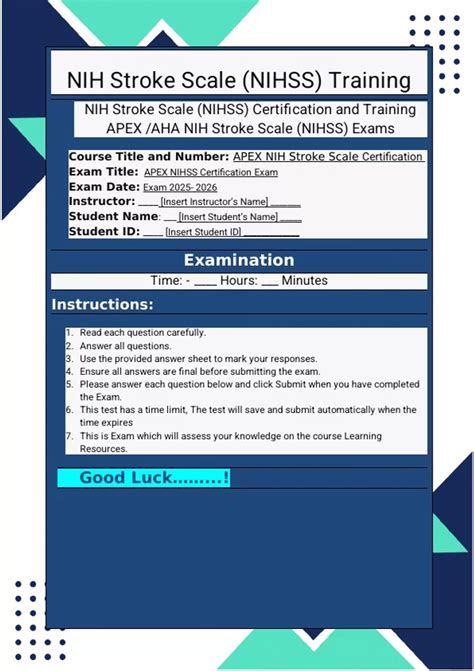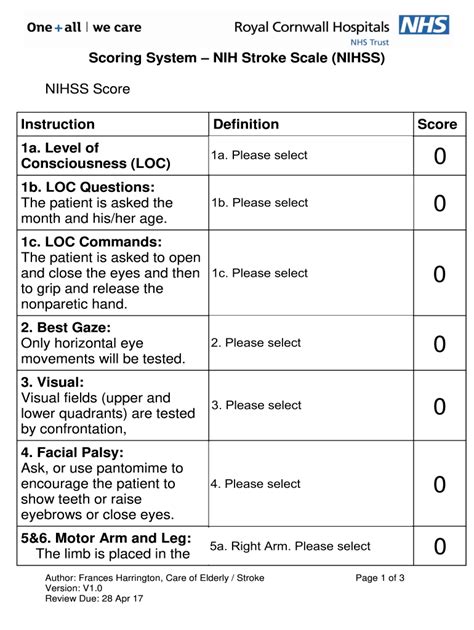Intro
Master the NIH Stroke Scale with ease! Our comprehensive guide provides a simplified approach to certification, covering essential components, scoring systems, and real-world applications. Boost your confidence and skills in assessing stroke severity with our expert tips and resources, ensuring accurate diagnoses and optimal patient care.
The NIH Stroke Scale (NIHSS) is a widely used assessment tool in the medical field, particularly in the evaluation and management of stroke patients. Obtaining NIH Stroke Scale certification can be a valuable asset for healthcare professionals, demonstrating their expertise and commitment to providing high-quality care. In this article, we will break down the NIH Stroke Scale certification process, its benefits, and provide tips and resources to make certification easier.

What is the NIH Stroke Scale?
The NIH Stroke Scale is a systematic assessment tool used to evaluate the severity of a stroke. It consists of 11 items, each assessing a specific aspect of neurological function, such as consciousness, language, and motor function. The scale is widely used in clinical settings to assess stroke patients, monitor their progress, and guide treatment decisions.
Benefits of NIH Stroke Scale Certification
Obtaining NIH Stroke Scale certification offers several benefits for healthcare professionals, including:
- Demonstrated expertise: Certification demonstrates that you have a thorough understanding of the NIH Stroke Scale and its application in clinical practice.
- Improved patient care: By accurately assessing stroke severity, you can provide more effective care and improve patient outcomes.
- Enhanced career opportunities: Certification can be a valuable asset when applying for jobs or advancing in your career.
- Professional development: The certification process can help you stay up-to-date with the latest research and best practices in stroke care.
NIH Stroke Scale Certification Process
The certification process typically involves the following steps:
- Meet the eligibility criteria: Check with the certifying organization for specific eligibility requirements, which may include education, experience, and licensure requirements.
- Complete a training program: Many organizations offer training programs or courses that prepare you for the certification exam.
- Pass the certification exam: The exam typically consists of a written or online component and a practical component, where you demonstrate your ability to administer the NIH Stroke Scale.
- Maintain certification: Certification is typically valid for a certain period, after which you must complete continuing education requirements or re-certify to maintain your certification.

Study Tips and Resources
To help you prepare for the certification exam, here are some study tips and resources:
- NIH Stroke Scale manual: Familiarize yourself with the official manual, which provides detailed instructions on administering the scale.
- Online courses and training programs: Take advantage of online courses and training programs that offer interactive learning and practice exams.
- Practice exams: Practice administering the NIH Stroke Scale on patients or using online simulations to improve your skills.
- Study groups: Join a study group or online community to connect with other healthcare professionals preparing for certification.
Common Challenges and Solutions
Some common challenges healthcare professionals face when preparing for NIH Stroke Scale certification include:
- Limited experience with the scale: Solution: Practice administering the scale on patients or using online simulations.
- Difficulty with certain items: Solution: Focus on the items that give you trouble and practice until you feel confident.
- Time management: Solution: Create a study schedule and stick to it to ensure you have enough time to prepare.

Conclusion
NIH Stroke Scale certification is a valuable asset for healthcare professionals, demonstrating expertise and commitment to providing high-quality care. By following the certification process, studying effectively, and overcoming common challenges, you can achieve certification and improve patient outcomes.
What is the NIH Stroke Scale?
+The NIH Stroke Scale is a systematic assessment tool used to evaluate the severity of a stroke.
What are the benefits of NIH Stroke Scale certification?
+Certification demonstrates expertise, improves patient care, enhances career opportunities, and promotes professional development.
How do I prepare for the certification exam?
+Study the NIH Stroke Scale manual, take online courses or training programs, practice administering the scale, and join a study group or online community.
We hope this article has provided you with valuable information and resources to help you achieve NIH Stroke Scale certification. Good luck!
